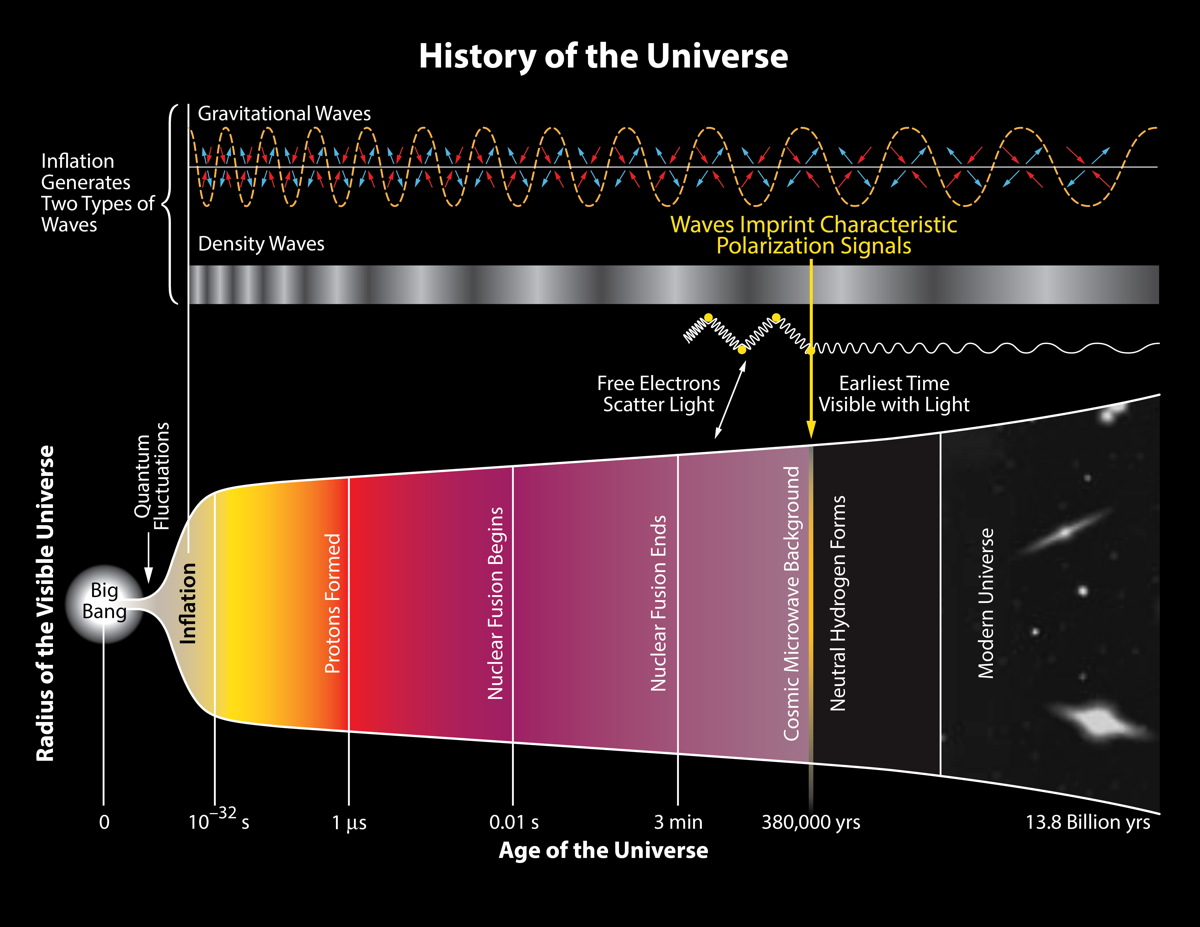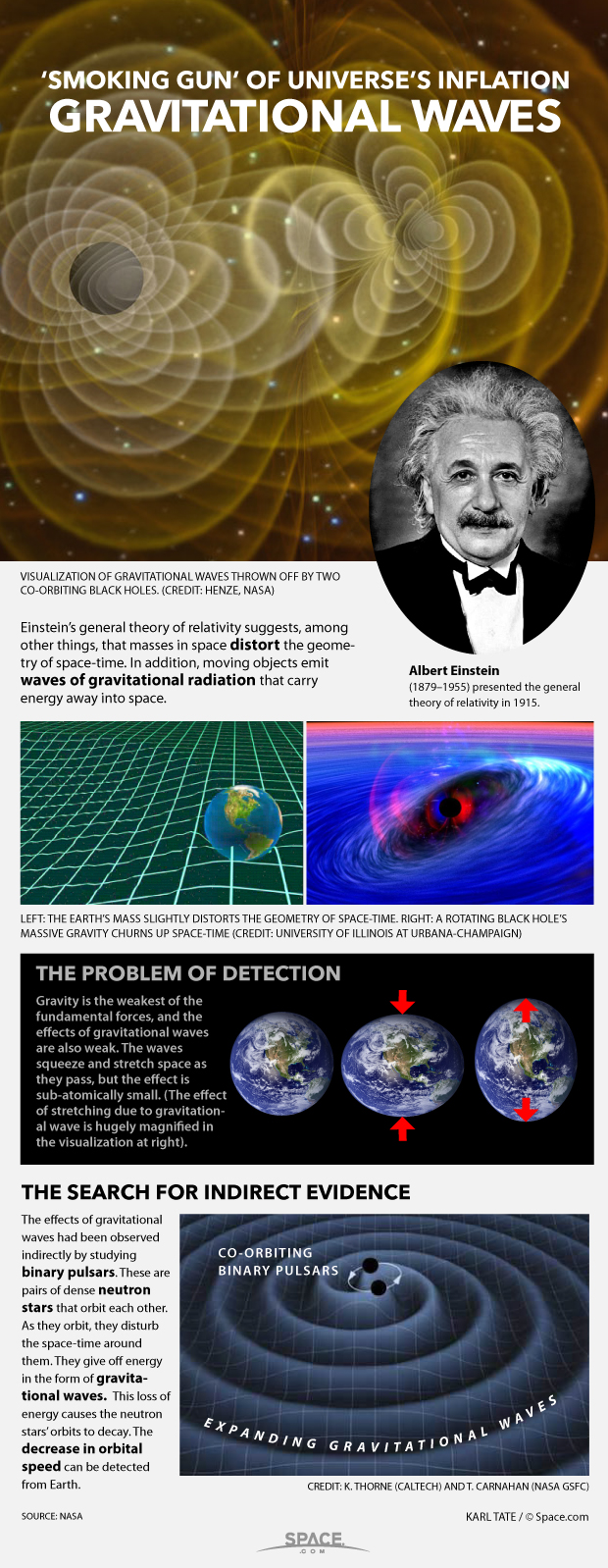
The oldest light in the universe still has some secrets to share.
In March, astronomers announced that the BICEP2 telescope at the South Pole had detected evidence of primordial gravitational waves in the cosmic microwave background (CMB), the ancient light that began saturating the universe 380,000 years after the Big Bang.
If it holds up, the discovery confirms the theory of cosmic inflation, which posits that the universe expanded much faster than the speed of light just after the Big Bang, exploding from minuscule quantum fluctuations into something of macroscropic size in a few tiny fractions of a second. [How Inflation Gave the Universe the Ultimate Kickstart (Infographic)]
Several teams of researchers around the world are thus racing to confirm this landmark find, looking for the gravitational-wave signature — a type of polarization in the CMB known as "B-modes" — in data gathered by their own instruments. But other astronomers are already looking ahead, considering what additional information they could prise out of the CMB with new and advanced tools.
And there is indeed still much to learn, astronomers Joseph Silk and Jens Chluba write in a "Perspectives" piece published online today (May 7) in the journal Science.
For example, a super-sensitive space-borne spectrometer could measure temperature variations in the CMB with unprecedented precision. These variations reveal areas of different density, which were the seeds that eventually gave rise to stars, galaxies and all the other cosmic structures seen today.
"The optimists would say that with such a huge improvement in sensitivity, one is bound to discover new physics, thereby opening an unexplored window to the early universe, peeking beyond the CMB anisotropies and deep into the pre-decoupling era," Silk and Chluba write, referring to the time when photons and matter were coupled together.
Breaking space news, the latest updates on rocket launches, skywatching events and more!
Until about 380,000 years after the Big Bang, the universe was a scorching-hot, opaque fog of plasma and energy. Then, in an epoch known as recombination, temperatures dropped enough to allow the formation of electrically neutral atoms, turning the universe transparent. Around this time, photons also decoupled from matter, and light began traveling freely through the cosmos, giving rise to the CMB.
A future space mission could specifically target the spectra of hydrogen and helium from this ancient epoch, potentially delivering a wealth of information to researchers, Silk and Chluba write.
"Detecting the recombination radiation would provide the ultimate proof that the universe cooled down from a hot primeval plasma, testing a fundamental aspect of the Big Bang model and providing a gold standard for measuring distortions produced by the earliest forming structure," they write.
Spotting these spectra will be a tall order, Silk said, adding that studies of potential CMB space missions are needed to determine if imaging spectrometers can deliver the required sensitivity.
"The major issue will be to dig deeply into the contribution from dusty galaxies that dominate the far infrared diffuse background at the frequencies where any spectral signature of the recombination of the universe might be detectable," Silk, of the Institut d’Astrophysique de Paris, told Space.com via email. "To overcome such a background probably requires high angular resolution in addition to the spectroscopic requirements."
CMB-studying missions known as PIXIE (Primordial Inflation Explorer) and PRISM (Polarized Radiation Imaging and Spectroscopy Mission) were proposed to NASA in 2011 and the European Space Agency in 2013, respectively. It's unknown at the moment if some variation or upgrade of PIXIE or PRISM could get the job done, said Chluba, who's based at Johns Hopkins University in Baltimore.
"That is one of the reasons we wrote this article, to get people thinking about all this, also with the 'ultimate' goal targeting the cosmological recombination lines in mind," Chluba told Space.com via email.
Future missions could aim even higher.
"A more exotic goal would be to seek spectroscopically deviant patches in the CMB sky, as traces of the formation of other universes," the pair write in Science. "These are predicted in eternal inflation, whereby vast numbers of other universes are envisaged to have peeled off from ours in the past in order to explain why we inhabit just one favorable patch of a vast and mostly inhospitable multiverse."
Some astronomers think that certain anomalies already observed in the CMB may indeed be signatures of the formation of other universes, Silk said. But he made clear that mounting a dedicated mission to hunt down or confirm these signatures would be no picnic.
"Here we are in science fantasy land," he said.
Follow Mike Wall on Twitter @michaeldwall and Google+. Follow us @Spacedotcom, Facebook or Google+. Originally published on Space.com.

Michael Wall is a Senior Space Writer with Space.com and joined the team in 2010. He primarily covers exoplanets, spaceflight and military space, but has been known to dabble in the space art beat. His book about the search for alien life, "Out There," was published on Nov. 13, 2018. Before becoming a science writer, Michael worked as a herpetologist and wildlife biologist. He has a Ph.D. in evolutionary biology from the University of Sydney, Australia, a bachelor's degree from the University of Arizona, and a graduate certificate in science writing from the University of California, Santa Cruz. To find out what his latest project is, you can follow Michael on Twitter.


